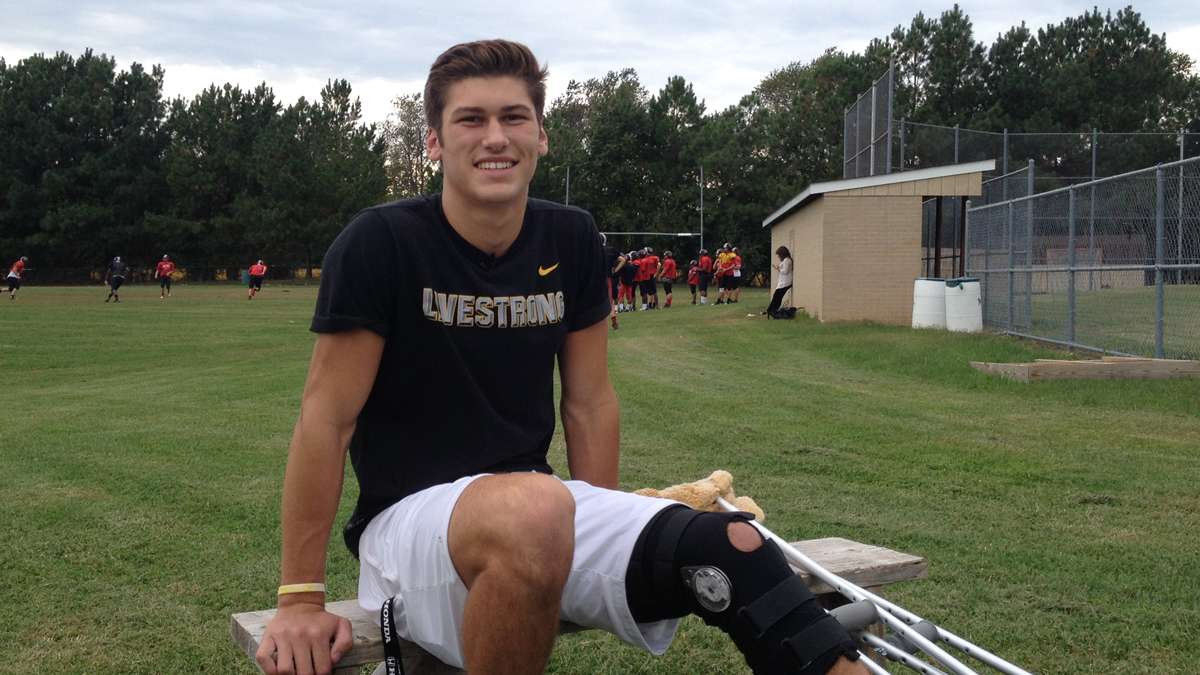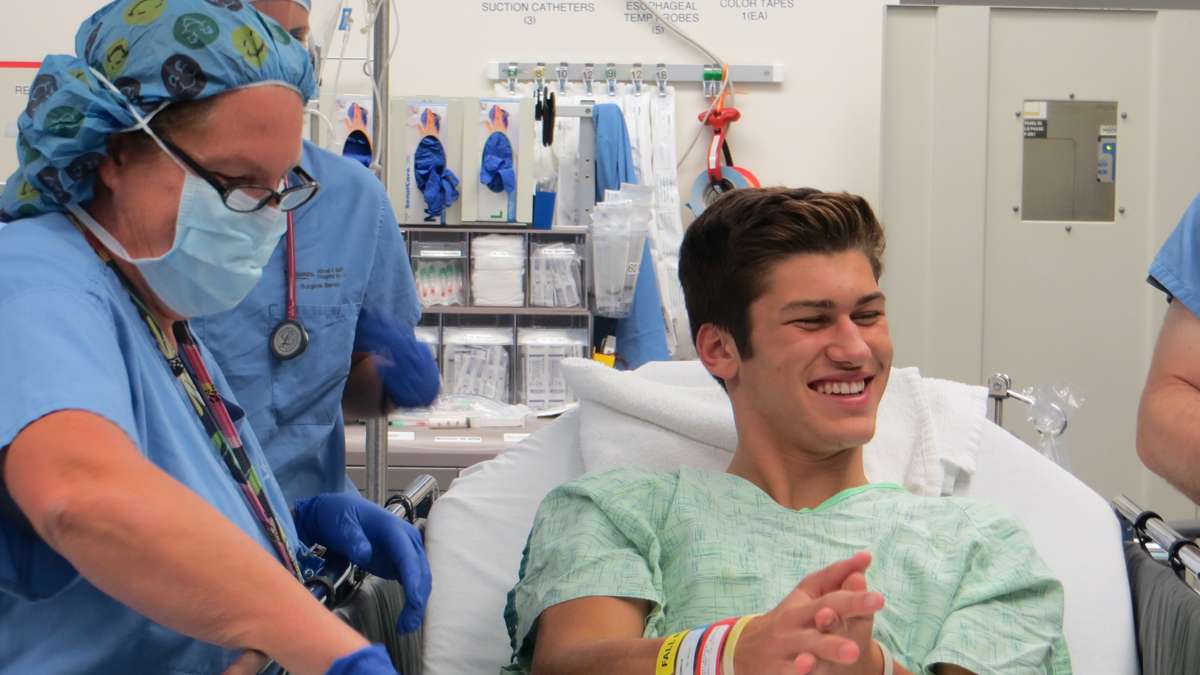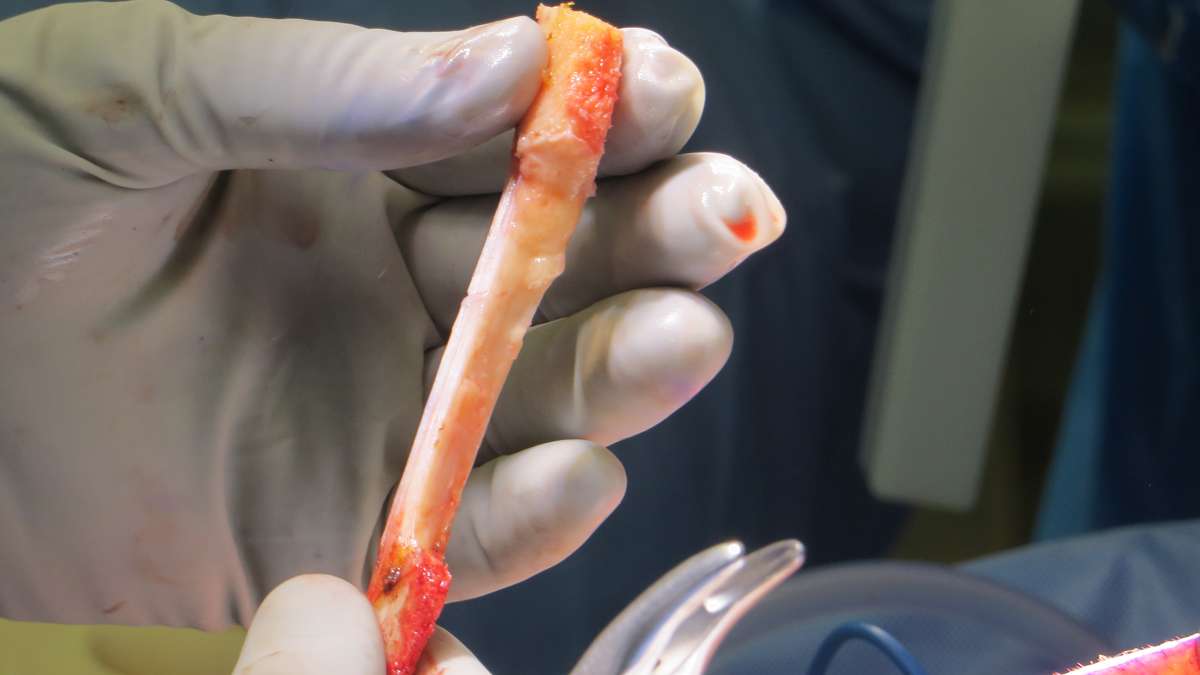Are super specialized, highly competitive sports contributing to more ACL tears among kids?
ListenFor young athletes, concussions have been a huge topic of concern. Now there’s another emerging trouble spot – knee injuries.
17-year-old high school football player Brennan Weber says he felt the same sickening ‘crunch’ that many people describe when they tear an ACL, or anterior cruciate ligament.
Brennan and the quarterback were warming up, passing the football back and forth.
“No one was around me,” said Weber, a senior at Polytech High School in Woodside, Delaware.
“I went backwards to go catch a ball over my left shoulder, I came down, caught the ball and I hyper-extended my leg, and buckled my knee, and I just fell forward straight on my face,” Weber said.
He knew he was hurt but convinced the athletic trainer to put him in the game anyway.
“I kind of like put on a show for them on the sideline, just to show ’em I’m fine. Any football player in that position–first game of the season–would definitely do the same. You just couldn’t think anything else besides just getting back in the game,” Weber said.
The ACL is a rubbery cord that helps connect the thighbone to the shinbone. It keeps the knee stable when you stop suddenly, or change direction quickly. Football, soccer and basketball all require those moves, and experts say ACL injury is too common among boys and girls who play those sports.
The American Orthopaedic Society for Sports Medicine has launched a campaign offering tips to prevent the often, season-ending knee injury.
ACL tears reported among young athletes have increased over two decades, but orthopedic surgeon Alfred Atanda said it’s hard to know if the rate of injury is higher—or if there are simply more teens competing in high-level sports.
“A lot of kids are super-specializing in an individual sport, and they are playing 12 months out of the year,” said Atanda, whose specialty is sports medicine at the Nemours A.I. duPont Hospital for Children in Wilmington, Delaware.
The same muscles, ligaments and tendons are used over and over and don’t have much chance to rest.
A surgery fix
Other countries manage ACL injuries differently, but in America, when an ACL tears, lots of young, competitive athletes end up in surgery.
Atanda said he never tells anyone they have to have surgery, but if an athlete wants to return to a high level of play and avoid leg instability in the future, surgery is the only choice, he said.
Atanda says the average surgeon does eight reconstructions each year, but he fixes one or two ACLs every week—all on kids.
Brennan Weber got his ACL reconstructed at Nemours Children’s Hospital, which has a center for sport medicine. Orthopedics had to find an extra long bed for him. He’s 6′ 4” and has size 17 feet.
Atanda is Weber’s knee surgeon. He made the repair arthroscopically—a less invasive approach to surgery, which uses a small incision, small instruments and a tiny camera. That approach comes with fewer complications, and helps patients get back on their feet quicker, Atanda said.
After making small holes in Weber’s knee, the surgery team used the camera to look inside and take pictures. Images of bone and cartilage flashed on T.V. monitors all around the room.
“It’s like playing a video game. It’s all about hand-eye coordination. You’re not looking at the knee, you’re looking at the screen. So you have to know where your hands are in space,” Atanda said.
First the team, trimmed the torn ligament and cleaned up ragged cartilage to prepare a space for the new ACL. Next they harvested a portion of tissue attached to Weber’s kneecap – called the patellar tendon. That tendon is the graft Atanda used to replace the old ACL.
Getting back to sports
Post surgery, Brennan Weber spends a couple days each week doing physical therapy rehabilitation.
Physical therapist Chas Barker at American Therapy & Rehab says the goal is to push Weber to recover without pushing him too hard.
After ACL surgery even professionals can take a year or more to feel confident again.
Lynn Snyder-Mackler, Alumni Distinguished Professor in the Department of Physical Therapy at the University of Delaware, says many know about Minnesota Vikings player Adrian Peterson’s phenomenal return to the NFL. “That same year, probably 40 percent of the guys never played again,” she said.
Weber opted for surgery because he says that’s his best chance to play Division Two football in college.
“That’s my goal to play next year, somewhere, anywhere,” he said. “Aw, man. The comeback. The plan is definitely be back playing football, basketball, everything in nine months, eight months. Hopefully quicker than that,” Weber said. “I feel like I can definitely return quicker than that.”
Student athletes tend to be a hard-working, optimistic bunch, Snyder-Mackler said.
“What I’m concerned about is their expectations are very high, said Snyder-Mackler. “The surgery is a big deal. The surgery is quite invasive.” Some young athletes underestimate what it takes to recover, she said.
“In six months or so they have their strength back, they have their motion back, it’s not swelling, but that graft isn’t healed,” Snyder-Mackler said. “You can’t rush biology.”
Looking for solutions
The University of Delaware has a 5-million dollar grant from the National Institutes of Health to explore solutions to ACL injury, including ‘downstream’ injuries.
“The younger and more active the patient is, the higher the rate of re-injury. In high school girls, it’s about 30 percent. That’s really high of either re-tearing that graft or tearing the other ACL,” Snyder-Mackler said.
In a survey of surgeons and therapists, researchers asked what they consider a success after ACL injury. Many people said: 1) returning to sports at the same level and 2) avoiding re-injury.
“To be honest we’re not really good at that,” Snyder-Mackler said.
Sport surgeons have always known they will see some of their ACL-repair patients again. But Snyder-Mackler says the newest research shows that young athletes are especially at risk for needing another fix. And data show that secondary injuries may be happening sooner than thought before.
“This is really new information we are trying to trickle down to clinicians,” she said.
Stay tuned, physical therapists at the University of Delaware are trying to figure out what it takes to prevent a second injury.
WHYY is your source for fact-based, in-depth journalism and information. As a nonprofit organization, we rely on financial support from readers like you. Please give today.









